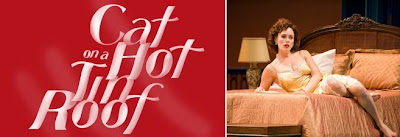Mendacious Heat
Well my friends, after a small holiday hiatus, I am back to the blog! This time, with a a play that comes stacked with motifs of deceit, mortality, sexuality, alcohol abuse, and wealth. Needless to say, its themes weigh heavy and its plot offers a stark transition from the jolly lot of shows that reigned over the Guthrie's play bill during the month of December.
Cat on a Hot Tin Roof has long been regarded as a story that captures a whirlwind of human emotion, chews it up, and spits it back out again in its most raw unadulterated form, and I love that about it. So did Tennessee Williams, and that puts me in good company (he once admitted this was his favorite of his plays). What makes this play so intense, you might ask? I would attribute it to Williams' mastery of the flawed character coupled with the fact that in Cat, there are a lot of them. It creates drama, real drama, that the Housewives of today just can't touch.
So how did the Guthrie's rendition stack up against my expectations? I think the only way for me to answer that question fairly is to divide the play in half (that is, after all, what intermission is for, right?).
In terms of steaminess, the first half, to me, felt like a lukewarm bath. While an overly pent up, sexually frustrated Maggie and indifferently drunk Brick are supposed to be hashing out all of the emotional drama that has been bottled up over what must feel like an eon, the scenes did not feel harsh enough for me. It was almost as if Peter Christian Hansen took Brick's indifference a little too far and he became merely a bystander to Emily Swallow's endless near-monologuing. I know that is how the script is written, but I wanted more emotion from both Maggie and Brick's characters. It just felt like a lot of talking, and what it should have felt like (in my opinion) was agony - the agony that comes from being stuck in a dying marriage. There were brief instances where this happened, but I wish that would have been more of a constant. Luckily the interweb guru's at the Guthrie have posted a video of one such occurence. Enjoy:
With that being said, once I was back in my seat following intermission, it was like a different show entirely. Mostly thanks to David Anthony Brinkley in his role as Big Daddy. Quite frankly, the only time I've actually spent in the South is a week in Booneville (pronounced Boon-Vul if you're a local), Arkansas - home of the bearcats (or burrrrcats)! While this in no way shape or form makes me an expert on Southern society, in this respect the Guthrie certainly captured what was in my imagination. Just like any good Southern head of household would do - he brought my need for poignancy to fruition. As an actor, his ability to command the stage was what impressed me most. When he spoke, I listened, and so did everyone around me. Not to mention, Act II is where the script heats up - which always helps. More is happening, conflict is rising, and the lies and family turmoil are intertwining tightly around each of the characters. Through Brinkley's prominent on-stage leadership, all of the other actors rally as well and I finally leaned a little farther forward in my seat.
Just like any good Southern head of household would do - he brought my need for poignancy to fruition. As an actor, his ability to command the stage was what impressed me most. When he spoke, I listened, and so did everyone around me. Not to mention, Act II is where the script heats up - which always helps. More is happening, conflict is rising, and the lies and family turmoil are intertwining tightly around each of the characters. Through Brinkley's prominent on-stage leadership, all of the other actors rally as well and I finally leaned a little farther forward in my seat.
I'd also like to give a blogger shout out to Rachel Hauck who was the set designer for the show. The set up was incredibly simple, but amazingly effective with it's giant doorways and turquoise hues. The airiness of bedroom made it truly feel like the open, grandieur layout of a plantation house, while the cool colored backdrop made the light cotton clothing worn by the actors pop dramatically. Kudos to Rachel!
All in all, I'd say the second half makes the show worthwhile and would be interested to hear other opinions on Act I. Thoughts anyone?
Later days, what is the victory of a cat on a hot tin roof?

0 comments:
Post a Comment